The ASRock X99 Extreme11 Review: Eighteen SATA Ports with Haswell-E
by Ian Cutress on March 11, 2015 8:00 AM EST- Posted in
- Motherboards
- Storage
- ASRock
- X99
- LGA2011-3
System Performance
Power Consumption
Power consumption was tested on the system while in a single MSI GTX 770 Lightning GPU configuration with a wall meter connected to the OCZ 1250W power supply. This power supply is Gold rated, and as I am in the UK on a 230-240 V supply, leads to ~75% efficiency > 50W, and 90%+ efficiency at 250W, suitable for both idle and multi-GPU loading. This method of power reading allows us to compare the power management of the UEFI and the board to supply components with power under load, and includes typical PSU losses due to efficiency. These are the real world values that consumers may expect from a typical system (minus the monitor) using this motherboard.
While this method for power measurement may not be ideal, and you feel these numbers are not representative due to the high wattage power supply being used (we use the same PSU to remain consistent over a series of reviews, and the fact that some boards on our test bed get tested with three or four high powered GPUs), the important point to take away is the relationship between the numbers. These boards are all under the same conditions, and thus the differences between them should be easy to spot.
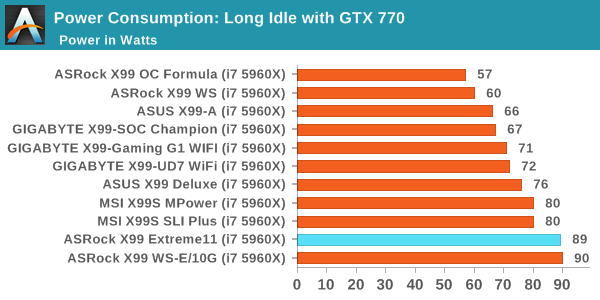

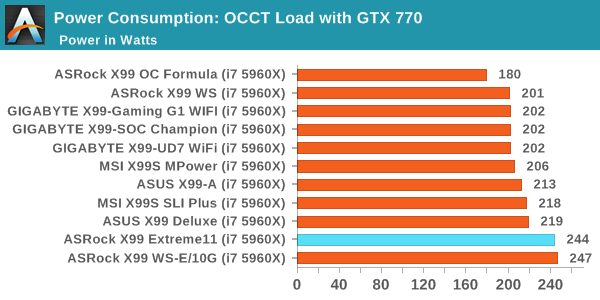
With the added PLX switches and LSI RAID controller, the Extreme11 was from the outset not going to be overly great when it came to power consumption. The same conclusions came from the ASRock X99 WS-E/10G with its power hungry 10G chip, and as a result these boards match each other both at idle and CPU load.
Windows 7 POST Time
Different motherboards have different POST sequences before an operating system is initialized. A lot of this is dependent on the board itself, and POST boot time is determined by the controllers on board (and the sequence of how those extras are organized). As part of our testing, we look at the POST Boot Time using a stopwatch. This is the time from pressing the ON button on the computer to when Windows 7 starts loading. (We discount Windows loading as it is highly variable given Windows specific features.)
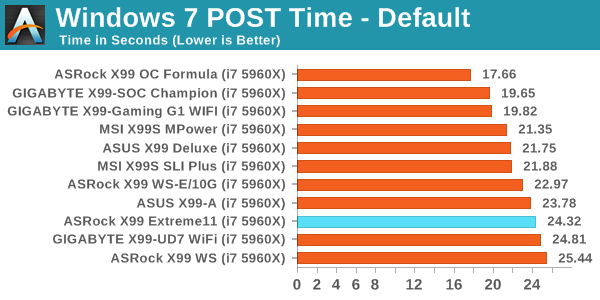
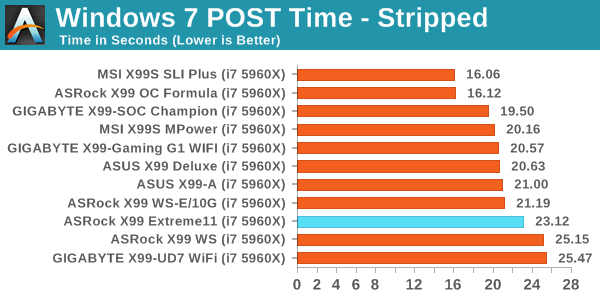
The extra controllers cause a small bump in POST time, with the final result being near the bottom of our testing results.
Rightmark Audio Analyzer 6.2.5
Rightmark:AA indicates how well the sound system is built and isolated from electrical interference (either internally or externally). For this test we connect the Line Out to the Line In using a short six inch 3.5mm to 3.5mm high-quality jack, turn the OS speaker volume to 100%, and run the Rightmark default test suite at 192 kHz, 24-bit. The OS is tuned to 192 kHz/24-bit input and output, and the Line-In volume is adjusted until we have the best RMAA value in the mini-pretest. We look specifically at the Dynamic Range of the audio codec used on board, as well as the Total Harmonic Distortion + Noise.
Dynamic Range of X99 Extreme11 at 100% volume

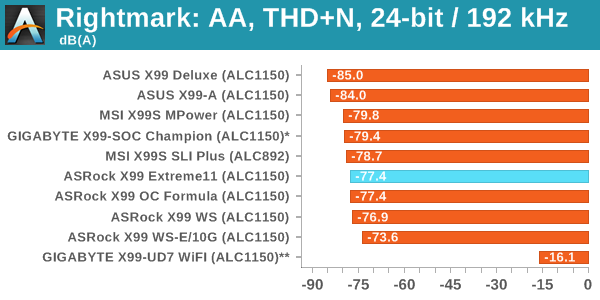
The Extreme11 results match what we have seen before on other ASRock X99 boards with Realtek ALC1150 audio codecs – around 103 dB for dynamic range and above -78 dB for THD+N.
USB Backup
For this benchmark, we transfer a set size of files from the SSD to the USB drive using DiskBench, which monitors the time taken to transfer. The files transferred are a 1.52 GB set of 2867 files across 320 folders – 95% of these files are small typical website files, and the rest (90% of the size) are small 30 second HD videos. In an update to pre-Z87 testing, we also run MaxCPU to load up one of the threads during the test which improves general performance up to 15% by causing all the internal pathways to run at full speed.

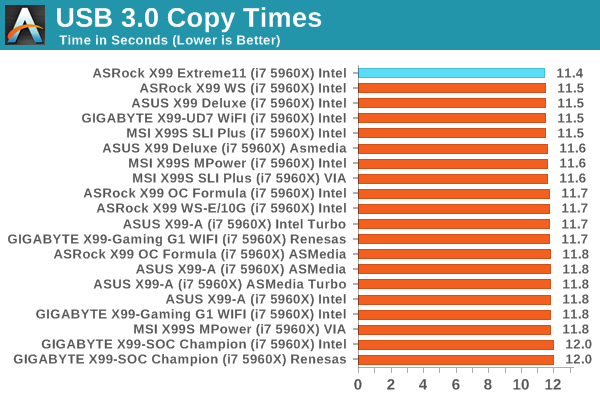
USB 2.0 performance is somewhat middling, but USB 3.0 performance on the PCH is some of the best we have seen.
DPC Latency
Deferred Procedure Call latency is a way in which Windows handles interrupt servicing. In order to wait for a processor to acknowledge the request, the system will queue all interrupt requests by priority. Critical interrupts will be handled as soon as possible, whereas lesser priority requests such as audio will be further down the line. If the audio device requires data, it will have to wait until the request is processed before the buffer is filled.
If the device drivers of higher priority components in a system are poorly implemented, this can cause delays in request scheduling and process time. This can lead to an empty audio buffer and characteristic audible pauses, pops and clicks. The DPC latency checker measures how much time is taken processing DPCs from driver invocation. The lower the value will result in better audio transfer at smaller buffer sizes. Results are measured in microseconds.
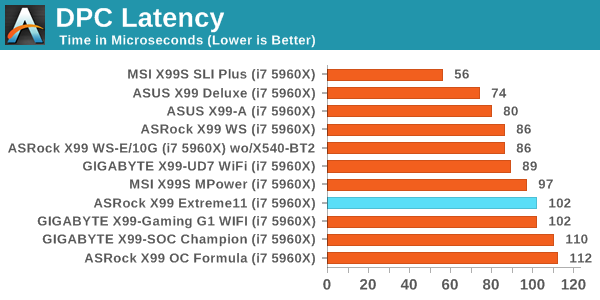
LSI 3008 Performance
Unlike our X79 Extreme11 review, I unfortunately did not have a series of SSDs on hand to test in a similar manner. Nevertheless, the implementation for the X99 version is the same as the X79, and to recap our X79 Extreme11 results gives the following for peak sequential read speeds. The legend gives our X79 setup in terms of SATA 6 Gbps ports + SATA 3 Gbps ports (thus 2+0 gives a RAID-0 array of two SATA 6 Gbps ports), with the final eight being solely populated on the LSI controller.
This in order to match the best PCH performance in this setup, it required three drives in RAID-0 on the LSI ports. Similar results can be extrapolated for X99 whereby six of the 10 SATA ports on the PCH are capable of RAID, and a similar number on the LSI would be needed to match it. Unfortunately any RAID array that crosses both the PCH and the LSI ports needs to be from software.



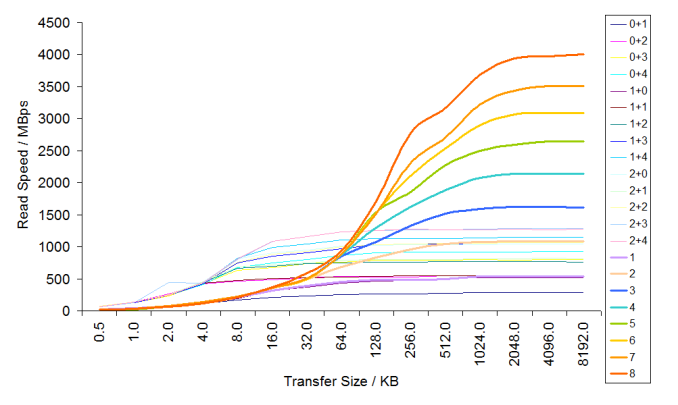








58 Comments
View All Comments
jasica - Thursday, March 19, 2015 - link
as a professionally i agreed with duploxxx there are no reason to buy this board. because every one is not like gaming !<a href="http://www.topmediabox.com/">Real TV</a>
Native7i - Thursday, April 23, 2015 - link
I expected more USB ports at rear panelSaelnaydar - Friday, May 15, 2015 - link
Hello,Not all sorage ports are usable the way you want or the way you think, raids ports are only bound to one part of connectors.
If you are using SATA-M2 cards, the connectivity shares bandwith with some ports and you have to figure out what are unshared ports that supports raids
SSD should be bound to some special ports and not shared with M2, raids .. Wiring setup and nightmare...the storage part is not as easy at it sounds.
More importantly for a 700 Euro card !
The 3 Way SLI Does not work out of the box, a big drawback for a 4X16x 3.0 PCIE Motherboard with 2 build in chipsets supporting up to 4XSLI
I finaly made it to 3 ways SLI
First 3 way it was buggy and achieved lesser performance than 2 Way SLI
With a lot of cards switch and testings i finaly "as a last option" updated BIOS to 1.2 (wich was not there in january whan i bought the MB)
The Bios flash to 1.2 of my Asrock X99 Extreme 11 made work the 3 ways SLI configuration.
There was no indication on forums or in bios update or release notes that the bios was fixing SLI but IT does for me.
afbfxt - Wednesday, November 11, 2015 - link
I promise this will be good and I guarantee you cant make this stuff up.The ASRock X99 Extreme11 advertizes itself as a MOBO that has 8 SAS-3 ports on it. However the SAS-3 ports are the same form factor as a seven-pin SATA connector. In the MOBO manual it states "For connecting SAS HDDs, please contact SAS data cable dealers" because ASRock does not include the SAS-3 cables necessary. So I contacted all the SAS-3 cable manufactures in the USA and they all said they have never heard of a SAS-3 cable that had a SFF-8482 connector on one end and a seven-pin SATA connector on the other end that supports 12 GB/s. So I e-mailed ASRock support and asked them if they knew where I could get a SAS-3 cable like this and they never responded. So I did a Google search to see if anyone was having the same problem and I found one other person that was. The whole reason why ASRock is charging over 600.00 dollars for this board is because it offers an LSI SAS 3008 SCSI controller on board but obviously it's completely useless, so they're just ripping you off.
At first I was extremely angry but after a few days I found this whole incident to be hilarious.
I mean, can you imagine a company doing something like this. LOL!!!!!!!!!
I would never buy anything from ASRock ever again and I don't recommend anybody buying anything from them either. I will stick with and recommend to others more reputable brands like ASUS, Gigabyte, MSI etc.
petar_b - Friday, January 29, 2016 - link
Did you try using regular SATA cable and power connector from your power supply ? You won't get far if you wish to use SFF-8482 ....afbfxt - Wednesday, November 11, 2015 - link
I promise this will be good and I guarantee you cant make this stuff up.The ASRock X99 Extreme11 advertizes itself as a MOBO that has 8 SAS-3 ports on it. However the SAS-3 ports are the same form factor as a seven-pin SATA connector. In the MOBO manual it states "For connecting SAS HDDs, please contact SAS data cable dealers" because ASRock does not include the SAS-3 cables necessary. So I contacted all the SAS-3 cable manufactures in the USA and they all said they have never heard of a SAS-3 cable that had a SFF-8482 connector on one end and a seven-pin SATA connector on the other end that supports 12 GB/s. So I e-mailed ASRock support and asked them if they knew where I could get a SAS-3 cable like this and they never responded. So I did a Google search to see if anyone was having the same problem and I found one other person that was. The whole reason why ASRock is charging over 600.00 dollars for this board is because it offers an LSI SAS 3008 SCSI controller on board but obviously it's completely useless, so they're just ripping you off.
At first I was extremely angry but after a few days (and my RMA approval) I found this whole incident to be hilarious. I mean, can you imagine a company doing something like this. LOL!!!!!!!!!
I would never buy anything from ASRock ever again and I don't recommend anybody buying anything from them either. I will stick with and recommend to others more reputable brands like ASUS, Gigabyte, MSI etc.
petar_b - Friday, January 29, 2016 - link
No it's not rip off. each plx has price of 60 usd (you can find this on web), SAS controller that one would buy as PCIe card is aprox 300, meanis you pay 420 usd here just for good SAS implementation (meaning you need PLX or you can't run dual graphic card setup without PLX - don't forget that SAS takes 4 lanes).Yes board could be cheaper, but it's a product for narrow audience... they have to compensate. ASUS WS, Gigabyte also use PLX, you can see how prices increase rapidly when they provide PLXes ...
There is no way out wihout PLX if you want SAS and multi graphic card setup.
d_sing - Tuesday, March 8, 2016 - link
Does anyone know if this board will support 8TB HDDs on all 18 ports at once? (i.e. 18 x 8TB = 144TB) Considering this board for a server build...